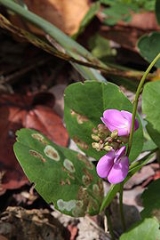
Canavalia rosea
Encyclopedia
Canavalia rosea is a species of flowering plant
of the genus Canavalia
in the pea
family, Fabaceae
, that has a pantropical
distribution. Common names include Beach Bean, Bay Bean, Seaside Jack-bean, Coastal Jack-bean, and MacKenzie Bean.

vine
that forms mats of foliage. Stems reach a length of more than 6 m (19.7 ft) and 2.5 cm (0.984251968503937 in) in thickness. Each compound leaf is made up of three leaflets 5.1–7.6 cm (2–3 in) in diameter, which will fold themselves when exposed to hot sunlight. The flowers are purplish pink and 5.1 cm (2 in) long. The flat pods are 10.2–15.2 cm (4–6 in) long and become prominently ridged as they mature. The buoyancy of the seeds allows them to be distributed
by ocean currents.The plant seems to contain L-Betonicine.
and prefers sand
y soils.
Flowering plant
The flowering plants , also known as Angiospermae or Magnoliophyta, are the most diverse group of land plants. Angiosperms are seed-producing plants like the gymnosperms and can be distinguished from the gymnosperms by a series of synapomorphies...
of the genus Canavalia
Canavalia
Canavalia is a genus of flowering plants in the legume family and comprises approximately 70-75 species of tropical vines. Members of the genus are commonly known as jack-beans. The species of Canavalia endemic to the Hawaiian Islands were named āwikiwiki by the Native Hawaiians...
in the pea
Pea
A pea is most commonly the small spherical seed or the seed-pod of the pod fruit Pisum sativum. Each pod contains several peas. Peapods are botanically a fruit, since they contain seeds developed from the ovary of a flower. However, peas are considered to be a vegetable in cooking...
family, Fabaceae
Fabaceae
The Fabaceae or Leguminosae, commonly known as the legume, pea, or bean family, is a large and economically important family of flowering plants. The group is the third largest land plant family, behind only the Orchidaceae and Asteraceae, with 730 genera and over 19,400 species...
, that has a pantropical
Pantropical
In biogeography, a pantropical distribution one which covers tropical regions of all of the major continents, i.e. in Africa, in Asia and in the Americas. Examples include the plant genera Acacia and Bacopa....
distribution. Common names include Beach Bean, Bay Bean, Seaside Jack-bean, Coastal Jack-bean, and MacKenzie Bean.

Description
Coastal Jack-bean is a trailing, herbaceousHerbaceous plant
A herbaceous plant is a plant that has leaves and stems that die down at the end of the growing season to the soil level. They have no persistent woody stem above ground...
vine
Vine
A vine in the narrowest sense is the grapevine , but more generally it can refer to any plant with a growth habit of trailing or scandent, that is to say climbing, stems or runners...
that forms mats of foliage. Stems reach a length of more than 6 m (19.7 ft) and 2.5 cm (0.984251968503937 in) in thickness. Each compound leaf is made up of three leaflets 5.1–7.6 cm (2–3 in) in diameter, which will fold themselves when exposed to hot sunlight. The flowers are purplish pink and 5.1 cm (2 in) long. The flat pods are 10.2–15.2 cm (4–6 in) long and become prominently ridged as they mature. The buoyancy of the seeds allows them to be distributed
Drift seed
Drift seeds and drift fruits are seeds and fruits adapted for long distance dispersal by water. Most are produced by tropical trees, and they can be found on distant beaches after drifting thousands of miles through ocean currents...
by ocean currents.The plant seems to contain L-Betonicine.
Habitat and range
C. rosea inhabits upper beaches, cliffs, and dunes throughout the world's coastal tropics. It is highly salt-tolerantHalophyte
A halophyte is a plant that grows where it is affected by salinity in the root area or by salt spray, such as in saline semi-deserts, mangrove swamps, marshes and sloughs, and seashores. An example of a halophyte is the salt marsh grass Spartina alterniflora . Relatively few plant species are...
and prefers sand
Sand
Sand is a naturally occurring granular material composed of finely divided rock and mineral particles.The composition of sand is highly variable, depending on the local rock sources and conditions, but the most common constituent of sand in inland continental settings and non-tropical coastal...
y soils.

